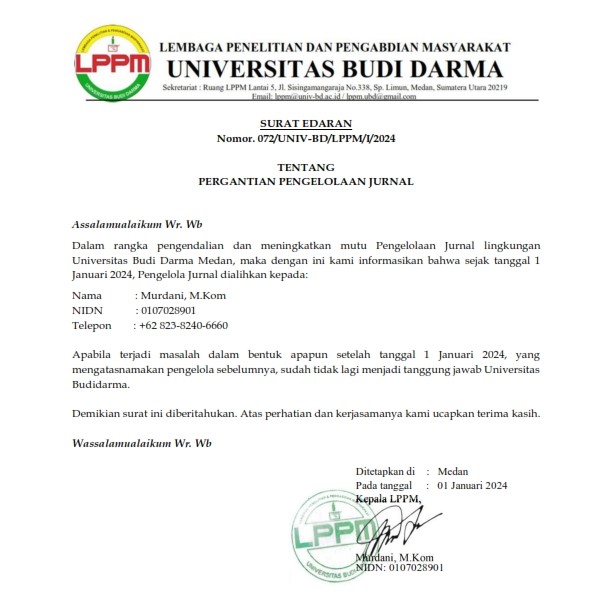Penerapan Deep Learning Menggunakan VGG-16 untuk Klasifikasi Citra Glioma
DOI:
https://doi.org/10.30865/json.v3i4.4122Keywords:
Glioma, Deep Learning, CNN, HE, VGG-16Abstract
One of the types of brain tumors in humans is glioma. Glioma is considered to be the most common type of primary brain tumor in adults. To determine the follow-up action that will be carried out by the doctor, the level of glioma needs to be known first. Glioma is divided into 3 grades. To be able to distinguish grades from gliomas, a classification process can be carried out using deep learning with CNN architecture. Glioma grade classification applies Histogram Equalization (HE) preprocessing. The training model uses CNN with the VGG-16 architecture. data using split data with a comparison of 70% training 30% testing, 80% training 20% testing, and 90% training 10% testing. The results of this study using original data have better results compared to data using HE preprocessing on batch size 16 testing and split data 90% training 10% testing.
References
P. Sun, D. Wang, V. C. Mok, and L. Shi, “Comparison of Feature Selection Methods and Machine Learning Classifiers for Radiomics Analysis in Glioma Grading,†IEEE Access, vol. 7, pp. 102010–102020, 2019, doi: 10.1109/ACCESS.2019.2928975.
P. Wesseling and D. Capper, “WHO 2016 Classification of gliomas,†Neuropathol. Appl. Neurobiol., vol. 44, no. 2, pp. 139–150, 2018, doi: 10.1111/nan.12432.
S. Kumar, A. Negi, J. N. Singh, and A. Gaurav, “Brain Tumor Segmentation and Classification Using MRI Images via Fully Convolution Neural Networks,†Proc. - IEEE 2018 Int. Conf. Adv. Comput. Commun. Control Networking, ICACCCN 2018, pp. 1178–1181, 2018, doi: 10.1109/ICACCCN.2018.8748614.
H. H. Sultan, N. M. Salem, and W. Al-Atabany, “Multi-Classification of Brain Tumor Images Using Deep Neural Network,†IEEE Access, vol. 7, pp. 69215–69225, 2019, doi: 10.1109/ACCESS.2019.2919122.
Z. Lu et al., “The classification of gliomas based on a Pyramid dilated convolution resnet model,†Pattern Recognit. Lett., vol. 133, pp. 173–179, 2020, doi: 10.1016/j.patrec.2020.03.007.
S. Lahmiri, “Glioma detection based on multi-fractal features of segmented brain MRI by particle swarm optimization techniques,†Biomed. Signal Process. Control, vol. 31, pp. 148–155, 2017, doi: 10.1016/j.bspc.2016.07.008.
A. Kabir Anaraki, M. Ayati, and F. Kazemi, “Magnetic resonance imaging-based brain tumor grades classification and grading via convolutional neural networks and genetic algorithms,†Biocybern. Biomed. Eng., vol. 39, no. 1, pp. 63–74, 2019, doi: 10.1016/j.bbe.2018.10.004.
W. Souma, I. Vodenska, and H. Aoyama, “Enhanced news sentiment analysis using deep learning methods,†J. Comput. Soc. Sci., vol. 2, no. 1, pp. 33–46, 2019, doi: 10.1007/s42001-019-00035-x.
S. Banerjee, B. R. Ghosh, A. Gangapadhyay, and H. S. Chatterjee, “Galaxy morphological image classification using resnet,†Iraqi J. Sci., vol. 62, no. 10, pp. 3690–3696, 2021, doi: 10.24996/ijs.2021.62.10.27.
J. Hu, X. Zhang, and S. Maybank, “Abnormal Driving Detection with Normalized Driving Behavior Data: A Deep Learning Approach,†IEEE Trans. Veh. Technol., vol. 69, no. 7, pp. 6943–6951, 2020, doi: 10.1109/TVT.2020.2993247.
W. Yang, L. Zhou, T. Li, and H. Wang, “A Face Detection Method Based on Cascade Convolutional Neural Network,†Multimed. Tools Appl., vol. 78, no. 17, pp. 24373–24390, 2019, doi: 10.1007/s11042-018-6995-0.
M. Havaei et al., “Brain tumor segmentation with Deep Neural Networks,†Med. Image Anal., vol. 35, pp. 18–31, 2017, doi: 10.1016/j.media.2016.05.004.
N. Veni and J. Manjula, “High-performance visual geometric group deep learning architectures for MRI brain tumor classification,†J. Supercomput., Mar. 2022, doi: 10.1007/S11227-022-04384-9.
O. N. Belaid and M. Loudini, “Classification of Brain Tumor by Combination of Pre-Trained,†2020, doi: 10.22059/jitm.2020.75788.
H. U. Jang, H. Y. Choi, D. Kim, J. Son, and H. K. Lee, “Fingerprint spoof detection using contrast enhancement and convolutional neural networks,†Lect. Notes Electr. Eng., vol. 424, pp. 331–338, 2017, doi: 10.1007/978-981-10-4154-9_39.
Y.-Q. Li, D.-T. Lin, and Z.-W. Yeh, “Improving Deep Learning for Face Verification Using Color Histogram Equalization Data Augmentation,†Proc. 5th World Congr. Electr. Eng. Comput. Syst. Sci., no. Mvml, pp. 1–7, 2019, doi: 10.11159/mvml19.103.
S. S. Pasha, P. S. Babu, and Z. Vakil, “Enhancement of MRI Brain Images with Histogram Equalization Techniques,†2019 Int. Conf. Emerg. Trends Sci. Eng. ICESE 2019, 2019, doi: 10.1109/ICESE46178.2019.9194629.
Downloads
Published
How to Cite
Issue
Section
License

This work is licensed under a Creative Commons Attribution 4.0 International License
Authors who publish with this journal agree to the following terms:
- Authors retain copyright and grant the journal right of first publication with the work simultaneously licensed under Creative Commons Attribution 4.0 International License that allows others to share the work with an acknowledgment of the work's authorship and initial publication in this journal.
- Authors are able to enter into separate, additional contractual arrangements for the non-exclusive distribution of the journal's published version of the work (e.g., post it to an institutional repository or publish it in a book), with an acknowledgment of its initial publication in this journal.
- Authors are permitted and encouraged to post their work online (e.g., in institutional repositories or on their website) prior to and during the submission process, as it can lead to productive exchanges, as well as earlier and greater citation of published work (Refer to The Effect of Open Access).





